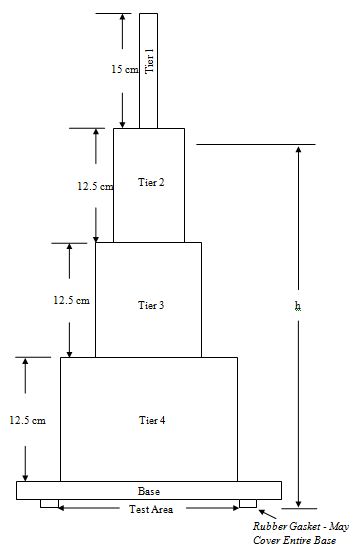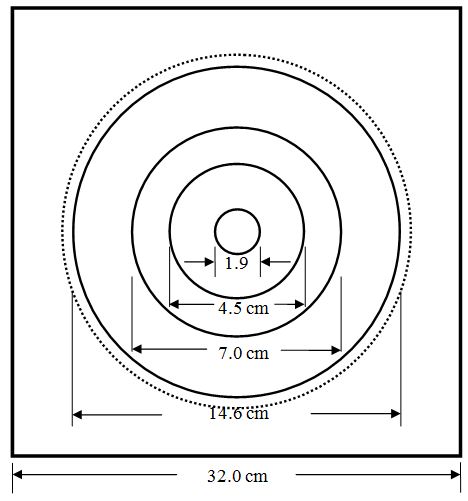106.3.2.83 TM-83, Field Estimation of Water Permeability of Compacted Asphalt Paving Mixtures
This test method is for the in-place estimation of the water permeability of compacted hot mix asphalt (HMA) pavement. The estimate provides an indication of water permeability of a pavement location as compared to those of other pavement locations.
The values stated in metric (SI) unit are regarded as standard. Values given in parenthesis are for information and reference purposes only.
This standard does not purport to address all of the safety problems associated with its use. It is the responsibility of the user of this standard to establish appropriate safety and health practices and determine the applicability of regulatory limitations prior to use.
Contents
106.3.2.83.1 Summary of Test Method
A falling head permeability test is used to estimate the rate at which water flows into a compacted HMA pavement. Water from a graduated standpipe is allowed to flow into a compacted HMA pavement and the interval of time taken to reach a known change in head loss is recorded. The initial and final head are measured from the pavement surface to the surface of the water. The coefficient of permeability of a compacted HMA pavement is then estimated based on Darcy’s Law.
106.3.2.83.2 Significance and Use
This test method provides a non-destructive means of estimating water permeability of compacted HMA pavements. The estimation of water permeability is based upon the following assumptions:
- the sample thickness is equal to the immediate underlying HMA pavement course thickness
- the area of the tested sample is equal to the area of the permeameter from which water is allowed to penetrate the HMA pavement
- one-dimensional laminar flow of water
- Darcy’s law is valid.
106.3.2.83.3 Apparatus
1) Hand broom – A broom of sufficient stiffness to sweep a test location free of debris.
2) Timing Device – A stopwatch or other timing device graduated in divisions of 1.0 seconds.
3) Sealant – Plumber’s putty to seal the permeameter to the pavement surface. A silicone-rubber caulk may be used in lieu of the plumber’s putty.
4) Weights – One piece or individual weights totaling 10 kg (20 lbs).
5) Field Permeameter – A field permeameter made to the approximate dimensions and specifications shown in Figs. 106.3.2.83.7.1 and 106.3.2.83.7.2.
6) Plastic Pipe and Funnel – A length of plastic pipe that will fit through Tier 1to aid in filling the permeameter minimizing entrapped air in the permeameter.
7) Measuring Device – A measuring stick having 0.1 cm increments to measure the beginning and ending head of water in the standpipe. It may be attached or imprinted as part of permeameter.
106.3.2.83.4 Preparation of Pavement Surface
Prior to conducting the test, a broom should be used to remove all debris from the pavement surface. Debris left on the pavement surface can hinder the sealing of the permeameter to the pavement surface. Care should be taken in marking the test location so that markings are not located in the test area.
106.3.2.83.5 Test Procedure
106.3.2.83.5.1 Permeameter Setup
Step 1. Ensure that the base plate and gasket are free of debris.
Step 2. Apply sealant around the perimeter of the test area.
Step 3. Place base containing the sealant onto the pavement surface. Evenly apply pressure to the top of the base with hand pressure to force the sealant into the surface voids.
Step 4. Place weight onto base plate. Apply hand pressure to weight to finalize sealing.
106.3.2.83.5.2 Pavement Saturation
Step 1. Fill the standpipe into Tier 3 of the permeameter.
Step 2. Allow the water to remain in Tier 3 for not less than one minute. It may be necessary to add water to keep the water level in Tier 3.
Step 3. Check for leaks through seal. If leaking is noted, apply additional hand pressure or repeat EPG 106.3.2.83.5.1.
106.3.2.83.5.3 Test
Step 1. To start the test, introduce water into the standpipe to a level just above the desired initial head and remove any large bubbles that may become freed during testing. (See Note 1.)
Step 2. When the water level is at the desired initial head, start the timing device. (See Note 2.) Stop the timing device when the water level within the standpipe reaches the desired final head. (See Note 3.) Record the tier, initial head, final head, and time interval between the initial and final head.
Step 3. Repeat steps 1 and 2 without removing the permeameter from the roadway.
- Note 1: For most applications, enough water should be introduced to bring the water level to the top of the top tier standpipe. In pavements with high permeability, the top tiers may be left unattached for 2-piece permeameters when the reading will be taken in the lower tiers. The initial and final head determinations should be made within the same tier standpipe.
- Note 2: For relatively impermeable pavements, the water level will drop very slowly within the top tier standpipe. Therefore, the initial head should be taken within Tier 1. For pavements of “medium” permeability, the water level will drop quickly through the Tier 1. Therefore, the initial head should be taken within the middle tier standpipes. For very permeable pavements the water level will drop very quickly through the top and middle tier standpipes but slow down when it reaches the bottom tier standpipe. Therefore, the initial head should be taken in the bottom tier standpipe.
- Note 3: Measurements should be made over a period of at least 1 minute. For consistency, a best practice is to collect measurements in the tier that has a 5 cm head loss over a 1 minute time span. For low permeability pavements, measure the head loss and stop the timer at 5 minutes.
106.3.2.83.6 Calculation
The coefficient of permeability, k, is estimated using the following equation:
- Where:
- k = coefficient of permeability, ft/day
- a = inside cross sectioned area of standpipe, cm2
- L = thickness of underlying HMA course, cm
- A = cross-sectioned area of permeameter through which water can penetrate the pavement, cm2
- t = elapsed time between h1 and h2
- h1 = initial head on the pavement location, cm
- h2 = final head on the pavement location, cm
- 2835 ft/day = 1 X 10-5 cm/sec
106.3.2.83.7 Report
Report average results for k to the nearest tenth in feet per day.


